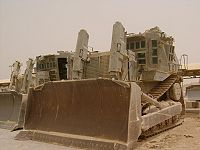משתמש:MathKnight/D9 armored bulldozer


The Israeli Armored D9 — nicknamed Doobi (תבנית:Lang-he; lit. teddy bear) — is a Caterpillar D9 bulldozer that was modified by the Israel Defence Forces, Israeli Military Industries and Israel Aerospace Industries to increase the survivability of the dozer in hostile environments and enable it to withstand heavy attacks.
The D9R, the latest generation of D9 bulldozers in IDF service, has a power of 410 horse power and drawbar pull of 71.6 metric tons (about 716 kN). It has a crew of two: operator and commander. It is operated by the TZAMA (צמ"ה = ציוד מכני הנדסי, Mechanical Engineering Equipment) units of the Israeli Engineering Corps.
The main IDF modification is the installation of an Israeli-made armor kit which provides armor protection to the mechanical systems and to the operator cabin. The operator and commander are protected inside an armored cabin ("the cockpit"), with bulletproof windows to protect against bombs, machinegun and sniper fire. The IDF also developed an slat armor add-on to deflect RPG rounds. The fitted armor package adds roughly 15 additional tons to the production-line weight of the D9. The modified D9 bulldozers can be fitted with disparate features, such as crew-operated machine guns, smoke projectors, or grenade launchers.
The IDF uses the D9 for a wide variety of engineering tasks, such as earthworks, digging moats, mounting sand barriers, building fortifications, rescuing stucked, overturned or damaged armored fighting vehicles (along with M88 Recovery Vehicle), clearing landmines, detonating IEDs and explosives, clearing terrain obstacles and opening routes to armored fighting vehicles and infantry, as well as structures demolition, including under fire.
During the Second Intifada the armoured D9 bulldozer gain notoriety as being an effective tool against terrorists and Palestinian threats, as they were almost impervious to Palestinian weapons and withstood even RPGs and Belly charges with more than 100kg and even half a ton of explosive. Therefore they used to open safe routes to IDF forces and detonate explosive charges. The bulldozer used extensively to clear shrubbery and structures which used as cover to Palestinian attacks. In addition they razed houses of families of suicide bombers. These action met criticism by Human Rights organizations and sometimes described as a collective punishment and claimed it breeds hatred more than it deters.
Following several incidents where armed Palestinians barricaded themselves inside houses and killed soldiers attempting to breach the entries, the IDF developed "Noal Sir Lachatz" (נוהל סיר לחץ "Pressure Pot Regulation") in which D9s and other engineering vehicles were used to bring them out by razing the houses; most of them surrendered because of fears of being buried alive but some, including senior terrorists, were killed when the bulldozers toppled the houses over them after they refused to surrender.
During the Battle of Jenin 2002 D9 bulldozers razed houses from which militants fired upon Israeli soldiers or contained possible IEDs and booby traps. After the deadly ambush in which 13 soldiers were killed the D9s razed the center of the camp and forced the remaining Palestinian militants to surrender, thus finishing the battle with an Israeli victory.
In Rafah and near the Philadelphie Route the D9s razed thousands of buildings according to human rights reports; Israel claimed it is a security measure necessary to discover and destroy smuggling tunnels and destroy firing positions that threaten the forces in the area, while Palestinians claimed it was to create a "buffer zone" and punish Palestinians for IDF casualties.
While Palestinians saw the D9 as a devastating weapon, and human rights groups criticized it for the massive damage it caused to Palestinian infrastructure, Israelis and military experts [1] saw the D9 as a necessary tool for combatting insurgency and terrorism and a key factor in reducing IDF casualties.
